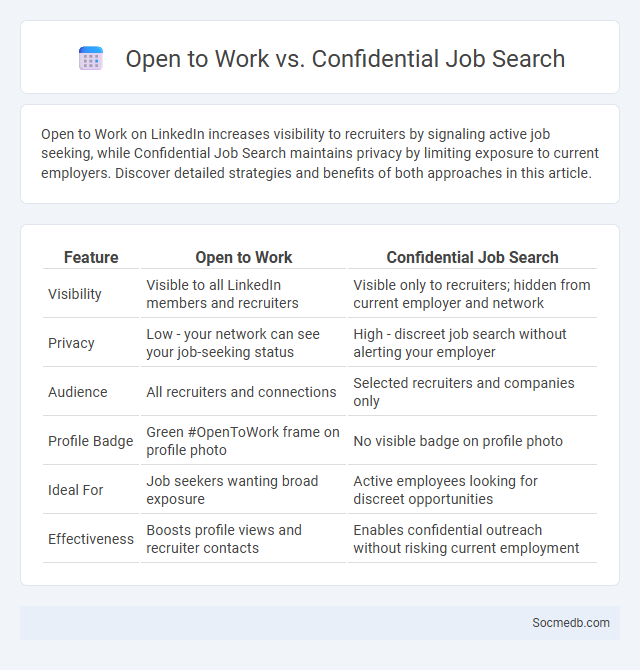
Photo illustration: Open to Work vs Confidential Job Search
Open to Work on LinkedIn increases visibility to recruiters by signaling active job seeking, while Confidential Job Search maintains privacy by limiting exposure to current employers. Discover detailed strategies and benefits of both approaches in this article.
Table of Comparison
| Feature | Open to Work | Confidential Job Search |
|---|---|---|
| Visibility | Visible to all LinkedIn members and recruiters | Visible only to recruiters; hidden from current employer and network |
| Privacy | Low - your network can see your job-seeking status | High - discreet job search without alerting your employer |
| Audience | All recruiters and connections | Selected recruiters and companies only |
| Profile Badge | Green #OpenToWork frame on profile photo | No visible badge on profile photo |
| Ideal For | Job seekers wanting broad exposure | Active employees looking for discreet opportunities |
| Effectiveness | Boosts profile views and recruiter contacts | Enables confidential outreach without risking current employment |
Understanding "Open to Work" on LinkedIn
Open to Work" on LinkedIn is a profile feature allowing users to signal recruiters and their network that they are actively seeking new job opportunities. This status increases profile visibility by appearing prominently in search results and displaying a distinctive green banner on the profile photo. Leveraging the "Open to Work" feature optimizes job search effectiveness by targeting relevant opportunities and enhancing recruitment engagement on the LinkedIn platform.
What is a Confidential Job Search?
A confidential job search involves discreetly exploring new employment opportunities without alerting the current employer or professional network. This approach often includes private job applications, restricted online profiles, and selective networking to protect the job seeker's privacy. Maintaining confidentiality prevents workplace tensions and ensures a smooth transition when a new position is secured.
The Job Seeking Badge: Visibility and Implications
The Job Seeking Badge on social media platforms enhances visibility for recruiters by clearly signaling an active job seeker status, increasing the likelihood of relevant job offers and networking opportunities. This feature leverages algorithm optimization to prioritize profiles with the badge, improving candidate discoverability in competitive job markets. Displaying the badge transparently communicates career intentions, helping to streamline the recruitment process while maintaining professional branding.
Pros and Cons of Open to Work Status
Displaying an "Open to Work" status on LinkedIn enhances your visibility to recruiters actively seeking candidates, increasing your chances for job opportunities and professional networking. However, this status may inadvertently signal job dissatisfaction to current employers or colleagues, potentially impacting workplace dynamics and your professional reputation. Balancing the benefits of increased exposure with the risks of perceived professional instability is crucial for managing your career trajectory effectively.
Confidential Job Search: Benefits and Challenges
Confidential job searches on social media platforms offer privacy by limiting visibility to current employers while enabling targeted networking with recruiters and industry professionals. Utilizing privacy settings and discreet messaging tools helps protect sensitive job-seeking activities from public exposure. Challenges include managing digital footprints, avoiding accidental information leaks, and balancing active job search engagement without raising suspicion among current colleagues.
How the Job Seeking Badge Affects Recruiter Perception
The Job Seeking Badge on social media profiles signals to recruiters that You are actively looking for new opportunities, increasing your visibility in candidate searches by up to 20%. This badge enhances recruiter perception by highlighting your proactive approach and readiness to engage, making You stand out in a competitive job market. Recruiters are more likely to prioritize candidates with this badge, viewing them as motivated and readily available for recruitment.
Navigating Privacy: Protecting Your Current Position
Social media platforms collect vast amounts of personal data, making privacy protection essential to safeguard your professional reputation and current position. Using stringent privacy settings, regularly reviewing permissions, and limiting the sharing of sensitive information helps minimize exposure to cyber threats and identity theft. Employers increasingly monitor social media activity, so maintaining a carefully managed online presence supports career stability and growth.
Which Job Search Approach Attracts More Opportunities?
Leveraging social media platforms such as LinkedIn significantly enhances job search outcomes by enabling direct connections with recruiters and industry professionals. Optimizing profiles with relevant keywords and engaging in targeted networking attracts more job opportunities compared to traditional application methods. Consistent activity, including sharing industry insights and participating in professional groups, increases visibility and credibility among potential employers.
Best Practices for Balancing Visibility and Discretion
Effective social media strategies balance visibility with discretion by tailoring content to target audiences while safeguarding personal information. Consistently reviewing privacy settings and limiting the sharing of sensitive details minimize potential risks. Engaging authentically through thoughtfully curated posts enhances brand presence without compromising confidentiality.
Choosing the Right Job Search Strategy for You
Identifying the right social media platforms tailored to your industry enhances job search effectiveness, with LinkedIn excelling in professional networking and Twitter offering real-time industry insights. Customized job search strategies involve leveraging platform-specific tools like LinkedIn's job alerts and groups or Twitter's hashtags to access hidden opportunities and connect directly with recruiters. Analyzing engagement patterns and content preferences within your target field ensures optimized visibility and maximizes networking potential.
 socmedb.com
socmedb.com